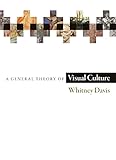A General Theory of Visual Culture / Whitney Davis.
Material type: TextPublisher: Princeton, NJ : Princeton University Press, [2022]Copyright date: ©2018Description: 1 online resource (400 p.) : 8 color + 163 b/w illusContent type:
TextPublisher: Princeton, NJ : Princeton University Press, [2022]Copyright date: ©2018Description: 1 online resource (400 p.) : 8 color + 163 b/w illusContent type: - 9781400836437
- ART / General
- ADAPT
- Aesthetic Theory
- Aestheticism
- Aesthetics
- Allegory
- Analogy
- Art criticism
- Art exhibition
- Art for art's sake
- Art history
- Art of memory
- Awareness
- Causal theory of reference
- Causality
- Cognitive anthropology
- Cognitive module
- Color scheme
- Comparative research
- Concept
- Conflation
- Connoisseur
- Consciousness
- Contextualism
- Courtauld Institute of Art
- Cultural artifact
- Cultural history
- Cultural icon
- Culturalism
- Culture theory
- Depiction
- Dissemination
- Emergence
- Engraving
- Explanation
- Feminist art
- Figurative art
- Fine art
- Formalism (art)
- Formality
- Handbook
- Historical method
- Human figure (aesthetics)
- Iconicity
- Iconography
- Iconology
- Ideation (creative process)
- Ideology
- Illustration
- Illustrator
- Individuation
- Intentionality
- Interaction
- Invention
- Language-game (philosophy)
- Languages of Art
- Level of analysis
- Level of consciousness (Esotericism)
- Mental image
- Metaphor
- Narrative
- Nominalism
- Notation
- Obfuscation
- Objectivity (philosophy)
- Ontology
- Ostensive definition
- Performativity
- Perspective (graphical)
- Pictorialism
- Pigment
- Platitude
- Pop art
- Positivism
- Precognition
- Publication
- Reflexology
- School of thought
- Self-consciousness
- Social theory
- Sociocultural evolution
- Sociology of culture
- Solipsism
- Sophistication
- Subjectivity
- Suggestion
- Symbol
- Symptom
- Theoretical definition
- Theory of Forms
- Theory of art
- Theory
- Thought experiment
- Thought
- Typography
- Visual arts
- Visual culture
- Visual perception
- Visual semiotics
- Work of art
- Writing
- 701/.03
- online - DeGruyter
| Item type | Current library | Call number | URL | Status | Notes | Barcode | |
|---|---|---|---|---|---|---|---|
 eBook
eBook
|
Biblioteca "Angelicum" Pont. Univ. S.Tommaso d'Aquino Nuvola online | online - DeGruyter (Browse shelf(Opens below)) | Online access | Not for loan (Accesso limitato) | Accesso per gli utenti autorizzati / Access for authorized users | (dgr)9781400836437 |
Frontmatter -- Contents -- Illustrations -- Preface -- PART ONE The Successions of Visual Culture -- Chapter 1 Vision Has an Art History -- Chapter 2 Vision and the Successions to Visual Culture -- PART TWO What Is Cultural about Vision? -- Chapter 3 What Is Formalism? -- Chapter 4 The Stylistic Succession -- Chapter 5 The Close Reading of Artifacts -- Chapter 6 Successions of Pictoriality -- Chapter 7 The Iconographic Succession -- Chapter 8 Visuality and Pictoriality -- Chapter 9 How Visual Culture Becomes Visible -- Chapter 10 Visuality and the Cultural Succession -- Notes -- Index
restricted access online access with authorization star
http://purl.org/coar/access_right/c_16ec
What is cultural about vision--or visual about culture? In this ambitious book, Whitney Davis provides new answers to these difficult and important questions by presenting an original framework for understanding visual culture. Grounded in the theoretical traditions of art history, A General Theory of Visual Culture argues that, in a fully consolidated visual culture, artifacts and pictures have been made to be seen in a certain way; what Davis calls "visuality" is the visual perspective from which certain culturally constituted aspects of artifacts and pictures are visible to informed viewers. In this book, Davis provides a systematic analysis of visuality and describes how it comes into being as a historical form of vision. Expansive in scope, A General Theory of Visual Culture draws on art history, aesthetics, the psychology of perception, the philosophy of reference, and vision science, as well as visual-cultural studies in history, sociology, and anthropology. It provides penetrating new definitions of form, style, and iconography, and draws important and sometimes surprising conclusions (for example, that vision does not always attain to visual culture, and that visual culture is not always wholly visible). The book uses examples from a variety of cultural traditions, from prehistory to the twentieth century, to support a theory designed to apply to all human traditions of making artifacts and pictures--that is, to visual culture as a worldwide phenomenon.
Mode of access: Internet via World Wide Web.
In English.
Description based on online resource; title from PDF title page (publisher's Web site, viewed 27. Jan 2023)


